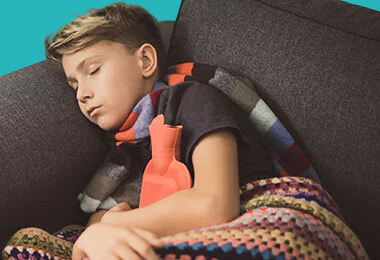Iron deficiency is one of the most common nutritional problems among children, especially in the early stages of development, as it directly affects energy, concentration, and immunity.
It is important to recognize the early symptoms of this condition to avoid its complications, as outlined below.
What is iron deficiency in children?
Iron deficiency is a condition in which the body's iron levels fall below normal, leading to decreased hemoglobin production, which is responsible for transporting oxygen to the body's cells.
It is the primary cause of anemia in children, as explained below.
Causes of iron deficiency in children
There are many causes of iron deficiency, often related to poor diet or rapid growth. The most important of these are:
- Not eating iron-rich foods, such as meat and leafy vegetables.
- Excessive reliance on milk without diversifying the diet.
- Malabsorption of iron in the intestine.
- Blood loss due to minor bleeding or intestinal parasites.
- Children's increased iron requirement during periods of rapid growth.
Iron Deficiency Symptoms

A number of signs alert parents to the presence of iron deficiency, such as:
- Pale skin and lips.
- General weakness and fatigue when playing or walking.
- Loss of appetite.
- Slow growth or poor academic performance.
- Cold extremities.
- Brilted hair and weak nails.
- Palpitations or occasional rapid heartbeat.
Diagnosis of iron deficiency in children
Diagnosis is made through a clinical examination and the following blood tests:
- Hemoglobin test to determine the level of anemia.
- Ferritin level measurement to assess the body's iron stores.
- Red blood cell count test.
Methods of treating iron deficiency
Treatment aims to raise iron levels in the body and restore the child's normal activity. It includes the following:
- Taking iron supplements as prescribed by a doctor in doses appropriate for the child's age.
- Encourage consumption of iron-rich foods, such as liver, red meat, spinach, lentils, and beans.
- Enhance iron absorption by consuming vitamin C with meals.
- Reduce excess milk consumption, which may hinder iron absorption.
- Regular follow-up with a doctor to monitor progress.
Complications of Iron Deficiency in Children

If left untreated, iron deficiency can lead to complications such as:
- Delayed mental and physical development.
- Weakened immunity and increased susceptibility to infection.
- Behavioral disturbances and difficulty concentrating.
- Severe anemia requiring urgent medical intervention.
Methods for Preventing Iron Deficiency
Iron deficiency can be prevented by following the following guidelines:
- Providing a balanced diet containing animal and plant sources of iron.
- Gradually introducing iron-rich foods after the sixth month of age.
- Regularly checking iron levels, especially for children at risk of deficiency.
- Encourage your child to eat citrus fruits to improve iron absorption.
Does iron deficiency affect a child's behavior?
Yes, iron deficiency can cause distraction, poor concentration, and excessive irritability.
Do all children need iron supplements?
No, only children with a proven deficiency through blood tests, under the supervision of a doctor.
How long does it take to treat iron deficiency?
Treatment usually lasts from two to three months, depending on the severity of the deficiency and the body's response.
Can excessive iron cause harm?
Yes, taking iron supplements without a prescription can lead to iron poisoning, so it's important to adhere to the dosage prescribed by your doctor.
Article Summary
Iron deficiency in children is a problem that can easily be prevented through a balanced diet and regular checkups.
Early treatment ensures healthy growth and prevents complications that could affect their future.